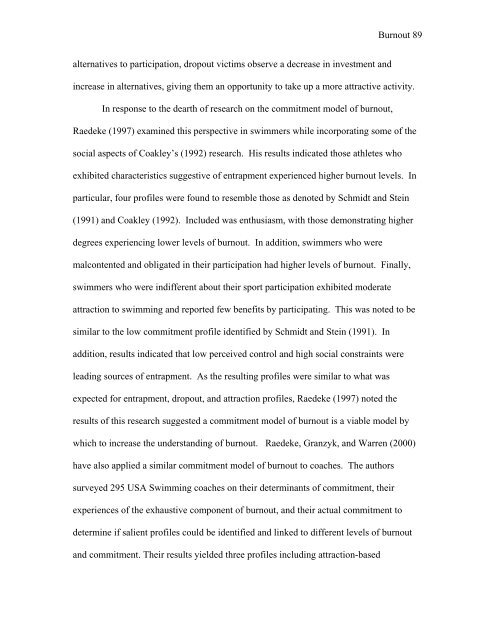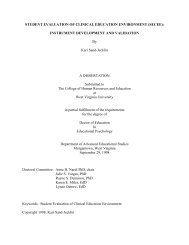Coach and Athlete Burnout - West Virginia University
Coach and Athlete Burnout - West Virginia University
Coach and Athlete Burnout - West Virginia University
You also want an ePaper? Increase the reach of your titles
YUMPU automatically turns print PDFs into web optimized ePapers that Google loves.
alternatives to participation, dropout victims observe a decrease in investment <strong>and</strong><br />
<strong>Burnout</strong> 89<br />
increase in alternatives, giving them an opportunity to take up a more attractive activity.<br />
In response to the dearth of research on the commitment model of burnout,<br />
Raedeke (1997) examined this perspective in swimmers while incorporating some of the<br />
social aspects of Coakley’s (1992) research. His results indicated those athletes who<br />
exhibited characteristics suggestive of entrapment experienced higher burnout levels. In<br />
particular, four profiles were found to resemble those as denoted by Schmidt <strong>and</strong> Stein<br />
(1991) <strong>and</strong> Coakley (1992). Included was enthusiasm, with those demonstrating higher<br />
degrees experiencing lower levels of burnout. In addition, swimmers who were<br />
malcontented <strong>and</strong> obligated in their participation had higher levels of burnout. Finally,<br />
swimmers who were indifferent about their sport participation exhibited moderate<br />
attraction to swimming <strong>and</strong> reported few benefits by participating. This was noted to be<br />
similar to the low commitment profile identified by Schmidt <strong>and</strong> Stein (1991). In<br />
addition, results indicated that low perceived control <strong>and</strong> high social constraints were<br />
leading sources of entrapment. As the resulting profiles were similar to what was<br />
expected for entrapment, dropout, <strong>and</strong> attraction profiles, Raedeke (1997) noted the<br />
results of this research suggested a commitment model of burnout is a viable model by<br />
which to increase the underst<strong>and</strong>ing of burnout. Raedeke, Granzyk, <strong>and</strong> Warren (2000)<br />
have also applied a similar commitment model of burnout to coaches. The authors<br />
surveyed 295 USA Swimming coaches on their determinants of commitment, their<br />
experiences of the exhaustive component of burnout, <strong>and</strong> their actual commitment to<br />
determine if salient profiles could be identified <strong>and</strong> linked to different levels of burnout<br />
<strong>and</strong> commitment. Their results yielded three profiles including attraction-based












